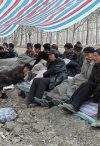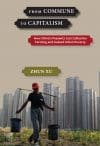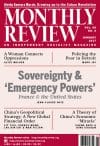Asia

There is considerable debate within China about the nature of the economy, including recognition of tendencies toward state capitalism. Consequently, most writers focus theorization of the many possible paths the economy could take—whether toward or away from capitalism. The present article takes a step further, arguing that the Chinese system today still contains some key components of socialism and is compatible with a market, or market-based, socialism that is clearly distinct from capitalism. | more…

The modernization paradigm pursued by China has tended to privilege industry over agriculture, urban over rural, and the middle class over the subaltern, with the country’s growth statistics and policy emphases accordingly geared to such a paradigm. This has resulted in almost mindless degradation of nature. The key question China faces is thus not one of more progress or more growth, but of the multiple tasks of reversing the dire damage already done to its ecology, society, and culture. | more…

Although the 1967 revolutionary armed peasant uprising in Naxalbari, at the foot of the Indian Himalayas, was brutally crushed, the insurgency gained new life elsewhere in India. In fact, this revolt has turned out to be the world’s longest-running “people’s war,” and Naxalbari has come to stand for the road to revolution in India. What has gone into the making of this protracted Maoist resistance? Bernard D’Mello’s fascinating narrative answers this question by tracing the circumstances that gave rise to India’s “1968” decade of revolutionary humanism and those that led to the triumph of the “1989” era of appallingly unequal growth condoned by Hindutva-nationalism, the Indian variant of Nazism. | more…

Since the late 1990s, China’s economic expansion has depended on an immense pool of cheap labor. Today, as wages increase and manufacturing operations leave the country, there are constant complaints about shortages of peasant workers. But has China really entered a new era of labor shortage? | more…

Throughout China’s nearly seventy-year history of industrialization and financialization, whenever the cost of an economic crisis could be transferred to the rural sector, capital-intensive urban industries have had a “soft landing” and existing institutional arrangements have been maintained—a pattern that continues today. We argue that Chinese peasants and rural communities have rescued the country from no fewer than ten such economic crises. | more…

In the early 1980s, China undertook a massive reform that dismantled its socialist rural collectives and divided the land among millions of small peasant families. Known as the decollectivization campaign, it is one of the most significant reforms in China's transition to a market economy. From the beginning, the official Chinese accounts, and many academic writings, uncritically portray this campaign as a huge success, both for the peasants and the economy as a whole. This mainstream history argues that the rural communes, suffering from inefficiency, greatly improved agricultural productivity under the decollectivization reform. It also describes how the peasants, due to their dissatisfaction with the rural regime, spontaneously organized and collectively dismantled the collective system. A closer examination suggests a much different and more nuanced story. By combining historical archives, field work, and critical statistical examinations, From Commune to Capitalism argues that the decollectivization campaign was neither a bottom-up, spontaneous peasant movement, nor necessarily efficiency-improving. | more…

Beyond the Rule of Capital?
Three hundred years after what became known in the nineteenth century as the Great Game—a struggle for regional hegemony between the British and Russian Empires—Southwest Asia remains an imperial staging ground. The U.S. invasion of Afghanistan in September 2001 signaled Washington’s desire to cement its hegemonic position, but seventeen years later it is mired in an unwinnable war, even as the U.S. economy—and that of much of the Western world—endures the “endless crisis” of contemporary capitalism. | more…

Thoughts on the Transition between Modes of Production on the Occasion of the Marx Bicentennial
Revolution is still on the agenda for the global periphery. Restorations in the course of socialist transition are not irrevocable—and in the weak links of the center, breaks in the imperialist front are not inconceivable. | more…

Challenges to Eurocentrism
The decline of Western dominance over the capitalist world system and the concurrent rise of Asia demand a deconstruction of the accepted wisdom of economic history. Understanding the legacy of Eurocentrism in both the rise of capitalism and its historiography is necessary if we are to challenge the dominant discourse and ideological assumptions of the so-called “European miracle.” | more…

Women's Labor and Resistance in Eastern India
Neoliberal development has opened the eastern Indian state of Odisha to mining companies and steel conglomerates, threatening the region’s ancient subsistence economies and provoking a fierce resistance, in which women have taken a leading role. | more…
Since the 1980s, economic growth in the core capitalist countries has been driven by an enormous expansion of financial capital, accompanied by steady deindustrialization. In recent years, the monopoly power of this financial capital has displayed increasingly tyrannical characteristics: it depends for its continued growth on ever-increasing indebtedness and dependence in developing nations, widening the divide between rich and poor and ultimately fostering state violence that serves to suppress popular resistance.… [Today,] military and monetary strength work together to profit from inequality and instability in emerging economies. | more…

Shortly after the election of Donald Trump, the alt-right organization Turning Point USA introduced its notorious Professor Watchlist…, listing some 200 radical academics in the universities as dangerous professors. Stories regarding this list were soon being carried in major papers throughout the country. In contrast to David Horowitz’s list of “the 101 most dangerous academics in America” a decade ago, the current Professor Watchlist has behind it the new sense of power on the extreme right provided by Trump’s electoral victory.… There can be no doubt that this is part of an attempted new McCarthyism. In terms of its overall orientation, the alt-right strategy here resembles the Gleichschaltung (“bringing into line”) in 1933–35 in Hitler’s Germany, where intimidation was directed at all the major cultural institutions, including universities, with the object of getting them to align with the new dominant views. | more…










